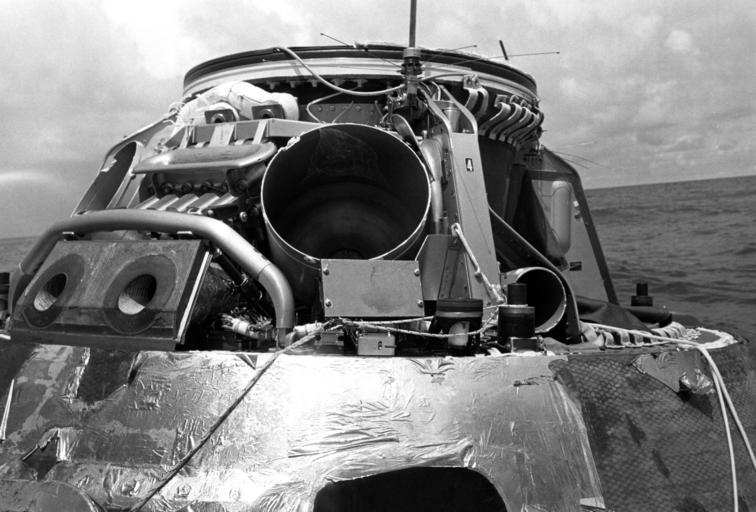MAKE A MEME
View Large Image

| View Original: | NASA_108-KSC-71P-503_aka_71-H-1250.jpg (7440x5040) | |||
| Download: | Original | Medium | Small | Thumb |
| Courtesy of: | www.flickr.com | More Like This | ||
| Keywords: Official NASA caption for this photo: "APOLLO 15 PACIFIC RECOVERY AREA – This unusual view of the Apollo 15 spacecraft was taken during recovery operations today in the Pacific Ocean at the conclusion of the nation’s fourth manned lunar landing mission. Key elements in the spacecraft’s earth landing system are shown. The large canister-like structure in the center in the center of the picture is one of two drogue mortar cans. Each houses a drogue parachute and the mortar shell which activates it when the spacecraft descends to 24,000 feet prior to splashdown. The drogue chutes orient and slow the spacecraft so that the main parachutes can be safely deployed. The second drogue mortar can is located adjacent to the one described at the viewer’s left. The smaller canister to the right and below the center drogue mortar can is one of three pilot parachute mortar cans. Activated at 10,000 feet, each pilot chute pulls out one of the spacecraft’s three main (large) parachutes housed in a compartment above it. To the left and below the center drogue mortar can, at the viewer’s left, are two reaction control thrusters used to stabilize the spacecraft during reentry. The spacecraft hatch is partially shown under these reaction control thrusters. The dark area in the lower center of the view is a side window. (Note the burned ablative material and exposed honeycomb caused by reentry temperatures.)” Official NASA caption for this photo: "APOLLO 15 PACIFIC RECOVERY AREA – This unusual view of the Apollo 15 spacecraft was taken during recovery operations today in the Pacific Ocean at the conclusion of the nation’s fourth manned lunar landing mission. Key elements in the spacecraft’s earth landing system are shown. The large canister-like structure in the center in the center of the picture is one of two drogue mortar cans. Each houses a drogue parachute and the mortar shell which activates it when the spacecraft descends to 24,000 feet prior to splashdown. The drogue chutes orient and slow the spacecraft so that the main parachutes can be safely deployed. The second drogue mortar can is located adjacent to the one described at the viewer’s left. The smaller canister to the right and below the center drogue mortar can is one of three pilot parachute mortar cans. Activated at 10,000 feet, each pilot chute pulls out one of the spacecraft’s three main (large) parachutes housed in a compartment above it. To the left and below the center drogue mortar can, at the viewer’s left, are two reaction control thrusters used to stabilize the spacecraft during reentry. The spacecraft hatch is partially shown under these reaction control thrusters. The dark area in the lower center of the view is a side window. (Note the burned ablative material and exposed honeycomb caused by reentry temperatures.)” | ||||